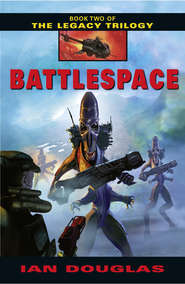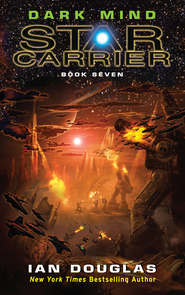По всем вопросам обращайтесь на: info@litportal.ru
(©) 2003-2024.
✖
Dark Matter
Настройки чтения
Размер шрифта
Высота строк
Поля
“Shadow One, America!” the voice of the ship’s CIC called. “What the hell are you doing there?”
“I . . . I’m not entirely sure, America. One second I was at the Black Rosette. The next . . .”
There was a long pause from the carrier, as though they were waiting for Walton to finish the thought. “Very well, Shadow One,” CIC replied after a moment. “You are cleared for approach and trap. C’mon in.”
“Copy. Accelerating.”
He didn’t trust himself to say more.
USNA CVS America
Omega Centauri
1205 hours, TFT
“So, we’re left knowing even less than we knew before,” Gray said. “Super-powerful aliens are dismantling a star cluster . . . and when one of our recon ships gets too close they teleport it across fifty AUs without even breaking a sweat. Recommendations?”
Gray was in America’s main briefing room with his command staff and department heads. Half were there physically; the rest had linked in from other parts of the ship. One entire bulkhead had been turned into a viewall, which was displaying video of Walton’s flyby of the Rosette. At the moment, it was showing the alien structures, looming vast and shadowy across the backdrop of stars.
“What . . . what they did to our recon fighter,” Lieutenant Commander Philip Bryant said slowly, shaking his head, “is flat-out impossible according to all of the laws of physics we understand.” He was the America’s chief stardrive engineer, and arguably the ship’s officer most conversant with her Alcubierre Drive and the essential malleability of empty space in the presence of powerful gravitational fields.
“The sheer power . . .” That was America’s other senior engineering officer, Commander Richard Halverson, the newly promoted head of the ship’s engineering department, and an expert on power taps and vacuum energy.
“Yeah. How the hell are we supposed to fight something like that?” Commander Dean Mallory was America’s chief tactical officer. “They could swat us like a bug if they wanted.”
“I don’t think the admiral was suggesting we fight,” Captain Connie Fletcher said. She was America’s CAG, an old acronym identifying a carrier’s Commander Air Group from back in the days of wet-Navy ships and aircraft. “That would be pretty pointless, right?”
“It would be more like fucking suicide,” Commander Victor Blakeslee, America’s senior navigation officer, said, scowling. “Recommendations? Hell, my recommendation is that we chart a course for home and high-tail it.”
“Assuming they let us go,” the voice of Acting Captain Gutierrez added. She was on America’s bridge, but telepresencing the planning session through her in-head. “It might not be that easy.”
“We have no reason yet to assume hostile intent on the part of the Rosette Aliens.” Lieutenant Commander Samantha Kline was the head of America’s xenobiology department—“X-Dep,” for short. “They could have vaporized Lieutenant Walton. Instead, they bent space to drop him back here.”
“I would remind you,” Halverson said slowly, “that those . . . those things out there did vaporize the Endeavor, the Herrera, and the Miller. If that’s not a hostile act, what the hell is?”
“The vid returned by the HVK robot is . . . open to interpretation, sir,” Kline replied. “That might have been an accident. Or a mistake . . .”
“A mistake by beings that powerful?” Fletcher said. “Beings that much like . . . like gods? That’s a pretty scary thought all by itself.”
“They are powerful,” Gray said. He wanted to redirect the session away from the aliens’ godlike aspect, however. He didn’t want his staff demoralized before they even encountered the Rosette Aliens directly. “But they’re not gods. If they did make a mistake when they destroyed the Endeavor, that would pretty much prove it, don’t you think?”
“More likely,” Dr. George Truitt said, “it simply means they don’t care. Keep in mind, people, that we could be dealing with a K-3 civilization here.”
Truitt was a civilian specialist assigned to America, and he was something of a wunderkind. He was a xenosophontologist, studying nonhuman minds and ways of thinking, and therefore worked in X-Dep under LCDR Kline.
Gray frowned at Truitt. In November, just two months ago, the man had been instrumental behind the scenes in devising a bit of offensive propaganda that had secured a Terran victory at Osiris—70 Ophiuchi A II—a colony world conquered by a Sh’daar client race called the Slan. By carefully analyzing communications with the Slan commander and what had been gleaned about their biology, Truitt and his xenosoph people had extrapolated a likely model of Slan psychology, one showing that they would be horrified at the idea of attacking their own community, an unthinkable act of barbarism . . . an act of animals. By beaming a message to the Slan suggesting that humans thought the same way Slan did, that humans actually shared the Slan collective-based psychology, Gray had forced the technologically superior Slan fleet to break off and retreat . . . a singular, spectacular victory.
And Truitt was the instrument of that victory.
It was too bad, Gray thought, that Truitt was also an egoistic grandstander, pompous, and possessing of social graces approximately on a par with wolverines.
“What the hell,” Mallory asked, “is a K-3 civilization?”
“Christ, you don’t know what Kardashev classification is?” Truitt said, glaring at Mallory. “I hope you understand tactics, Commander, better than you do technic sophontology.”
“Kardashev was a Russian astronomer,” Gray put in, “who developed a means of classifying planetary or interstellar civilizations based on how much energy they use. A K-3 civilization would use roughly as much energy as is emitted by all the stars of an entire galaxy.”
“That is a gross oversimplification,” Truitt said. “In point of fact—”
“If you please, Doctor,” Gray said sharply, interrupting, “we’re not here to argue definitions or sophontology. The Rosette Aliens have demonstrated the ability to rework an entire globular cluster, millions of stars—which, on the Kardashev scale, makes them at least a high K-2, and quite possibly a K-3. Human technology currently stands at . . . what is it, Doctor? K-1.2?”
“Approximately that,” Truitt said, “yes. But—”
“The point is that our industrious friends out there, as a civilization, routinely wield something like one hundred quintillion times more power than we can. I agree with Commander Blakeslee. There’s little we can do here, except establish automated monitoring stations.”
“Again, assuming they let us leave,” Captain Guiterrez said. “We are deep, deep inside their operational area.”
Gray opened a new channel within his in-head circuitry, and the bulkhead opposite the view of the cluster’s heart flowed and shimmered and then lit up with a schematic of the star cluster. The stars themselves were ghosted; otherwise, points of interest at the very center, including the position of America’s task force, would have been completely hidden.
With a thoughtclick, the view zoomed in on Omega Centauri’s heart. The entire cluster was a tightly packed ball of suns about 230 light years across, but the Black Rosette—and the majority of the alien constructs—was at the very center, and America and the other Earth ships were only 50 AUs away—no distance at all in interstellar terms. One AU was defined as the distance between Earth and her sun—150,000,000 kilometers, on average. A single light year was roughly equal to about 64,000 Astronomical Units.
It was interesting, Gray thought, not to mention quite worrying, that the aliens, whoever and whatever they were, had taken no apparent notice whatsoever of America and the ships with her. Carrier Battlegroup 40 consisted of the star carrier America; one cruiser, the Edmonton; three destroyers, the Ramirez, the John Young, and the Spruance; plus the provisioning ship Shenandoah. Though small as naval task forces went, the squadron represented a great deal of firepower, and yet the aliens had simply ignored them when they dropped out of their Alcubierre metaspace bubbles on the doorstep of . . . whatever the hell it was that they were building here.
But they’d moved Walton’s recon ship when it drifted in front of the Black Rosette. Maybe they did care about humans . . . that or else human activity actually could inconvenience them or somehow pose a threat to their operations.
Which was it? And how could the task force answer that question?
“How would X-Dep suggest we communicate with these . . . people?” Gray asked.
“We can’t,” Truitt said.
“We might try various Sh’daar languages,” Kline added. “The Agletsch trade pidgins.”
“Whoever the Rosette Aliens are,” Truitt said, “they likely come from a long way off. I doubt they’ve ever heard of the Sh’daar Collective or the Agletsch.”
The Agletsch were a galactic spacefaring species well known as traders of information. Two had been on board America until her last swing past Earth, when they’d disembarked for an extended chat with naval intelligence Earthside. The Agletsch were known to carry minute artificial intelligences within them, called Seeds, that communicated with the Sh’daar when they were within range. Having them on board a military vessel was always a risk, since the Sh’daar Seed might well compromise the ship’s security . . . but they were also incredibly useful as allies. Agletsch knowledge spanned a large fraction of the Sh’daar Collective, and their knowledge of artificial trade languages, developed to allow diverse members of the Collective to communicate with one another, had more than once proven vital.
“I’m not so sure about that,” Gray said. “We know the Rosette started off as the Six Suns, almost a billion years ago. We know that the Builders left TRGA cylinders scattered across the galaxy, and that those artifacts allow at least a limited form of time travel. The Rosette Aliens might be the Builders . . . and if so, they’ve had contact with the Collective . . . or at least with the Sh’daar of over eight hundred million years ago.”
The TRGA cylinder at Texaghu Resch had provided access to the Sh’daar inhabiting the N’gai Cloud 876 million years ago. It was generally believed, however, that the civilization that had constructed the TRGA cylinders was far older, and far more advanced, than even the now-vanished ur-Sh’daar.
“We have no evidence that these aliens are the Builders,” Truitt snapped. “The Builders in any case are probably long extinct.”
“I wonder?” Kline said. “A K-3 civilization might well be beyond threats of extinction. At the very least, they likely possess what for all practical intents and purposes amounts to both individual and cultural immortality.”
“Don’t you think that a true galaxy-wide civilization, a K-3,” Gray said, “would be aware of other K-3 level civilizations nearby? That they would be able to communicate with one another?”
“Some of the electronic Agletsch pidgins might be ideal for that,” Kline said. “They were designed for sapient species that have little or nothing in the way of biological similarities.”











